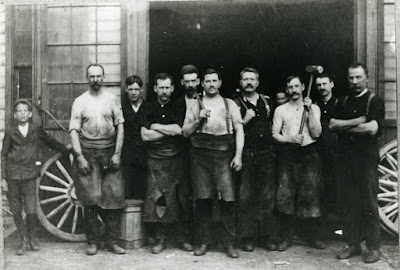An account book from Edward Ellis made us think about just how entwined horses were with life in Schenectady County. Whether for transport, work, or recreation, horses were an inseparable part of daily life and photos from our collection show just how important they were.
Edward Ellis was the third son of John and Mary Ellis. Edward succeeded to the presidency of the Schenectady Locomotive Works after the death of his brother Charles. He was also one of the residents responsible for bringing the Edison Machine Works to Schenectady. The account book runs from 1865 to 1896 and is a list of horses that Ellis bought and sold throughout his life. Towards the end of the account book, we found a few pages of newspaper clippings that explain why Edward was so interested in horses, horse racing. One of Edward's prized horses was named Ambulator. Ambulator is described as "not only a highly bred colt, but he is a race horse of the highest quality...He is not only fast, but he is game, and his owners believe that it will be no trouble for him to go a mile in 2:15 the coming season."
 |
| A listing for Edward Ellis' horse Ambulator. This seemed to be a pretty fair price as he was offered $3,000 at a later date. Courtesy of the Grems-Doolittle Library and Archives. |
 |
| Ambassador was the mother of Ambulator and also a fine race horse. Courtesy of the Grems-Doolittle Library and Archives. |
 |
| A photo from the Barden family file showing a young girl riding a pony. Courtesy of the Grems-Doolittle Library photo collection. |
 |
| The Hathaway Livery was located at 324-26 South Center Street (now Broadway). Hathaway's, started in 1890, was one of the premier livery services in Schenectady. The horses seen above were pure whites used mainly for funerals and parades, in the case of this photo, a parade. Hathaway Livery was not just used to haul people and Edward Hathaway hauled scenery for the Van Curler Opera Company. The mass production of cars sounded the death knell for many livery businesses. Hathaway's survived until shortly before World War I. Courtesy of the Grems-Doolittle Library photo collection. |
 |
| A horse drawn hearse on the frozen Mohawk River showing the iron bridge to Scotia in the background. Courtesy of the Grems-Doolittle photo collection. |
 |
| This photo shows an interesting view a horse drawn plow on restricted land on an island in the Mohawk. This land is possibly the Isle of Cayugas which can be seen on Google Maps. Courtesy of the Grems-Doolittle photo collection and Google Maps. |
 |
| An interesting colorized image from 1912 showing two horses in front of the Schenectady County Coal Company. Courtesy of the Grems-Doolittle Library photo collection. |
 |
A horse and dog combo from our collection. Unfortunately, not much else is known about this photo. Courtesy of the Grems-Doolittle Library photo collection.
Of course, where you have horses, you have horseshoes. The two photos above show some of the blacksmiths in the area. The first photos is of Lynch's Blacksmith Shop on Broadway and the second is the Glenville Village Blacksmith. Courtesy of Doolittle Library photo collection.
Found in a 1917 issue of the Daily Gazette, you can't help but feel a bit sorry for this mate-less horse. Courtesy of fultonhistory.com |












